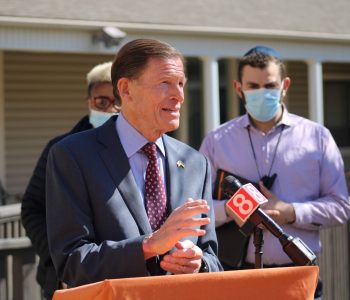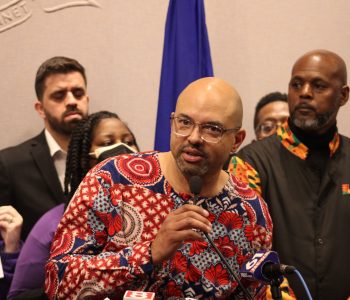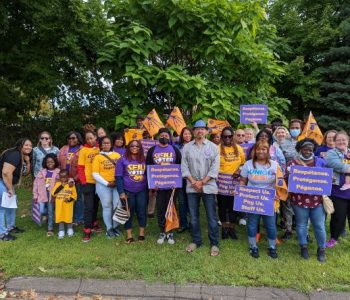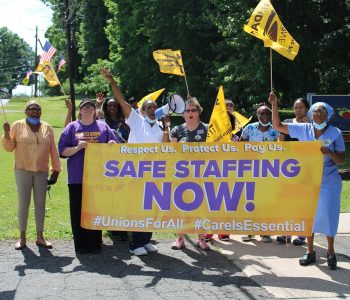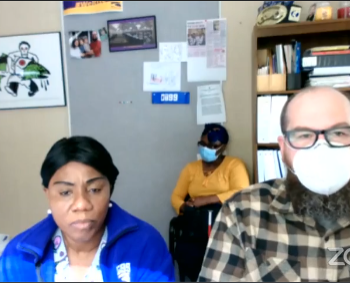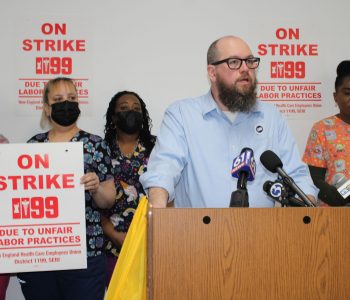Last spring, as coronavirus swept through Connecticut and the state’s nursing homes became ground zero for deadly outbreaks, nursing aide Gloria Duquette pushed aside her fear and continued showing up for her shifts.
Duquette was working upward of 80 hours many weeks between her two jobs at Kimberly Hall South in Windsor and Saint Mary Home in West Hartford, stringing together enough hours to pay her bills despite concerns of catching the disease.
But in July, after occupancy at the homes dropped, rehabilitation services slowed down and a floor at one of the facilities was closed as part of a planned renovation, Duquette’s hours were drastically scaled back. She’s now working 48 hours a week, which nets her less than $500, and struggling to pay her rent and utility bills.
“I feel like we were used,” said Duquette, of Bloomfield, who has watched several of her colleagues at Saint Mary lose their jobs recently. “Nobody cares about us.”
The problem is playing out across the industry. As nursing home residents die and the facilities see far fewer short-term residents – people who need rehabilitation or other post-acute care – homes are left with more empty beds. Weakened by revenue loss and added expenses associated with the pandemic, nursing homes in Connecticut are now resorting to widespread layoffs and reductions in employee hours.

That has left thousands of workers – predominantly Black and Latina women – without jobs or with smaller paychecks. New England Health Care Employees, District 1199 SEIU, which represents about 6,000 nursing home staff members, said about 2,000 of those employees have been laid off or have had their hours cut by 50% or more in July and August. At least 500 of the 2,000 affected members were laid off. Another 500 have been moved to a per diem list, meaning they have no scheduled hours, but they technically still have a job.
Connecticut nursing home leaders say they do not know how many total layoffs have been implemented across the industry this summer. Representatives at several of the state’s large nursing home chains declined to comment or would not provide specifics. At the height of the pandemic, when operators of those facilities worried they would not have enough staff, the industry employed more than 31,000 workers.
The loss of a job is difficult at any time. But nursing home employees say the layoffs and cutbacks are especially cruel now, after they spent months putting their health at risk by going to work. More than 3,400 nursing home employees in Connecticut have contracted COVID-19 or were presumed to have the virus. At least 18 have died and others have infected their families.
“This is what we get after being through COVID,” said Ingrid Francis, a certified nursing assistant at the Westside Care Center in Manchester, whose weekly hours were recently cut from 32 to 24. “We are angry.”
‘It’s like we’re nothing’
The last six months have been difficult for Duquette. Residents she had become attached to were getting sick and dying. Colleagues caught the virus. At the start of every shift she wondered if she was next.
One day after work Duquette had a headache and felt a burning sensation in her nostrils. A test result confirmed she had COVID-19. Before the illness ran its course, her husband spiked a fever and started to vomit.
“I know I got him sick,” she said. He was out of work for a month.

After the trauma of working daily near sickness and death, the loss of her hours was a devastating blow. Duquette had been putting in as many as 40 hours a week at Saint Mary before it was cut down to 16.
The average pay for a certified nursing assistant in Connecticut is $15 per hour. For non-union members, it can be as low as $12. Since her hours were reduced, Duquette has been short on her rent, and had to work out a payment plan with her utility company to catch up on bills.
“It’s like we’re nothing to them,” she said. “Management doesn’t care. The government doesn’t care. Nobody cares.”
Christine Looby, a spokeswoman for Trinity Health of New England Senior Communities, which owns Saint Mary and nine other nursing homes, confirmed layoffs and reductions in hours had occurred in the network, but could not provide specifics on Saint Mary.
“Organization-wide we made some very painful decisions, and certainly that was also true at Saint Mary Home,” she said. “As the census within Saint Mary Home came down, it became necessary for us to make sure the building was appropriately staffed at the level we were serving.”
State health department records show 37 residents have died of COVID-19 in the building, about 19% of its population. Ninety residents, or about 46%, were diagnosed with coronavirus.
For Francis, the nursing aide at Westside Care Center, losing eight hours of work per week was maddening.

At the height of the pandemic, when facilities were worried about staffing levels because so many workers were getting sick or had to quarantine, managers were insistent that the remaining staff take no time off. That meant months of long days in scary conditions, with no breaks.
“We worked above and beyond into COVID, and we didn’t get time off,” she said. “So now, with the layoffs, we’re upset. I’m upset. My co-workers are upset.”
One of her colleagues, who has a child with disabilities, was laid off. Another had her weekly hours reduced from 40 to 16. And it’s not just nursing aides. Housekeeping staff, dietary workers and nurses have been laid off or are working fewer hours.
Francis is looking for a second job.
“This is the way they’ve paid us back,” she said. “I feel they don’t care. They only care about [lining] their pockets.”
Financial troubles
Nursing home leaders say the pandemic has caused financial hardship for many facilities that already were operating on narrow margins. The sharp drop in revenue from fewer people seeking rehabilitation and other post-acute care was a troubling setback. As COVID-19 cases continued to climb last spring, some families pulled loved ones out of nursing homes or decided against putting them into one. Since the pandemic started, 2,872 nursing home residents have died – 64% of the state’s coronavirus fatalities – and 8,816 have been infected.
In February, just before COVID-19 reached Connecticut, the average occupancy in nursing homes was 87%, according to Department of Social Services records. By August, the average occupancy had dropped to 72%.
Facility leaders say it’s unclear when – or if – the homes will go back to their previous levels.
“The dramatic drop in nursing home occupancy and the consequence of employee staffing reductions during the census recovery period is yet another casualty of this unforgiving pandemic,” said Matthew Barrett, president and CEO of the Connecticut Association of Health Care Facilities. “Nursing home operators will continue to face these grim realities well into 2021 until occupancy recovers.”

“As unavoidable as it is,” he added, “it is especially troubling when you consider the critical role nursing home staff have played in getting our state to the other side of the pandemic.”
The nursing homes also endured increased costs for protective gear like masks, gloves and gowns, and for additional staffing at the height of the pandemic.
The state granted the facilities a 10% Medicaid rate increase in March as coronavirus began to spread. Medicaid covers roughly 70% of all nursing home care provided in Connecticut.
In April, Gov. Ned Lamont’s administration bumped that increase to 15%. And in May and June, Lamont used a portion of Connecticut’s federal Coronavirus Relief Fund allocation to give the homes an effective 20% Medicaid hike each month.
Before the fiscal year ended, the industry had received about $50 million from those increases. Barrett said the higher Medicaid rates have not continued into the current fiscal year, which began July 1, putting a strain on the facilities.
Nursing home officials have asked the state to direct more than $300 million in additional support to Connecticut’s 213 facilities. They are in negotiations.
Leaders of several of the state’s large nursing home chains declined to discuss the layoffs. A spokeswoman for Genesis Healthcare, which owns 18 homes in Connecticut, declined to comment, as did a spokesman for Athena Healthcare. A representative for Apple Rehab, which has 24 facilities across Connecticut and Rhode Island, did not return a call seeking comment.
Looby, the Trinity Health spokeswoman, said the company employs about 1,200 people at its 10 facilities. Since March, 60 workers have been laid off, had their hours reduced or were furloughed but later returned to the job. She did not provide a breakdown based on circumstance or facility.

Looby said there were no immediate plans to bring back the laid off employees, but that could change if the nursing homes’ occupancy goes back up.
“If the censes were to grow in a post-pandemic world, then certainly we would staff appropriately as we got back to that full capacity,” she said.
David Skoczulek, vice president of business development for iCare Health Network, which owns 11 nursing homes in the greater Hartford area, did not reveal how many layoffs the company had done, but said that as occupancy dropped, iCare has maintained the same per-resident staffing ratios.
He estimated the company now has 200 to 225 more vacant beds than at the start of the pandemic – representing about 15% of the overall beds.
“It’s not the first reaction, for a company to reorganize and do layoffs,” he said. “The first reaction is to figure out how to be as efficient as possible. But there’s so many pressures on skilled nursing facilities. Even without COVID, there’s so little margin that as soon as there’s a shift like this … you have to make some serious adjustments.”
Searching for work
Leaders at SEIU 1199, Connecticut’s largest health care workers union, are trying to connect out-of-work nursing home staff with facilities that still are hiring. They’re also helping thousands of employees who got sick in April, May and June – and lost out on pay – file workers’ compensation claims.
The situation is heartbreaking, they said. One employee whose hours were substantially cut asked union leaders if he should begin panhandling.

“That’s how we’re leaving these people who worked in the largest global pandemic in our lifetime, risking their health,” said Jesse Martin, a vice president with 1199. “The story is the same for thousands of our members. And there are thousands of non-union workers who have no process to be able to reduce hours at their nursing home in a fair, reasonable way.”
Some workers have been criticized for taking jobs in more than one nursing facility, since travel between the homes could increase the likelihood of spreading the virus. But the recent cuts have left even more employees seeking a second job.
Martin suggested that as the industry prepares for a possible second wave of COVID-19, the state and nursing home companies put together a registry of workers who have been laid off. The registry would allow facilities to quickly add staff if coronavirus cases swell again.
“The people who’ve been let go are having a tremendously hard time finding other employment,” he said. “People who have worked in a nursing home as many as 10, 15, 20 years are now seeing their hours drastically reduced. It’s very hard to deal with. They have a real uncertainty.”
